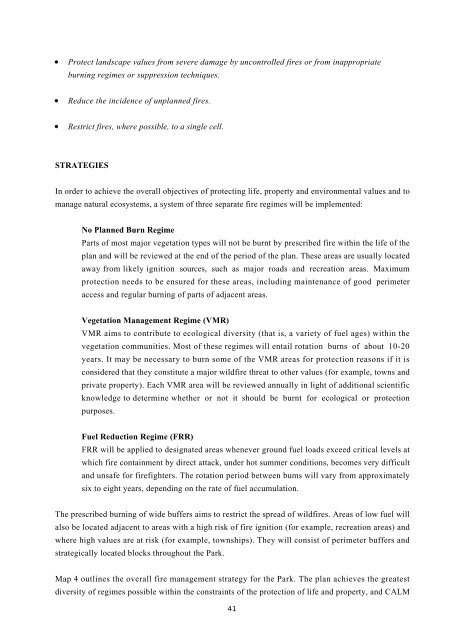Walpole-Nornalup National Park - Department of Environment and ...
Walpole-Nornalup National Park - Department of Environment and ...
Walpole-Nornalup National Park - Department of Environment and ...
Create successful ePaper yourself
Turn your PDF publications into a flip-book with our unique Google optimized e-Paper software.
• Protect l<strong>and</strong>scape values from severe damage by uncontrolled fires or from inappropriate<br />
burning regimes or suppression techniques.<br />
• Reduce the incidence <strong>of</strong> unplanned fires.<br />
• Restrict fires, where possible, to a single cell.<br />
STRATEGIES<br />
In order to achieve the overall objectives <strong>of</strong> protecting life, property <strong>and</strong> environmental values <strong>and</strong> to<br />
manage natural ecosystems, a system <strong>of</strong> three separate fire regimes will be implemented:<br />
No Planned Burn Regime<br />
Parts <strong>of</strong> most major vegetation types will not be burnt by prescribed fire within the life <strong>of</strong> the<br />
plan <strong>and</strong> will be reviewed at the end <strong>of</strong> the period <strong>of</strong> the plan. These areas are usually located<br />
away from likely ignition sources, such as major roads <strong>and</strong> recreation areas. Maximum<br />
protection needs to be ensured for these areas, including maintenance <strong>of</strong> good perimeter<br />
access <strong>and</strong> regular burning <strong>of</strong> parts <strong>of</strong> adjacent areas.<br />
Vegetation Management Regime (VMR)<br />
VMR aims to contribute to ecological diversity (that is, a variety <strong>of</strong> fuel ages) within the<br />
vegetation communities. Most <strong>of</strong> these regimes will entail rotation burns <strong>of</strong> about 10-20<br />
years. It may be necessary to burn some <strong>of</strong> the VMR areas for protection reasons if it is<br />
considered that they constitute a major wildfire threat to other values (for example, towns <strong>and</strong><br />
private property). Each VMR area will be reviewed annually in light <strong>of</strong> additional scientific<br />
knowledge to determine whether or not it should be burnt for ecological or protection<br />
purposes.<br />
Fuel Reduction Regime (FRR)<br />
FRR will be applied to designated areas whenever ground fuel loads exceed critical levels at<br />
which fire containment by direct attack, under hot summer conditions, becomes very difficult<br />
<strong>and</strong> unsafe for firefighters. The rotation period between bums will vary from approximately<br />
six to eight years, depending on the rate <strong>of</strong> fuel accumulation.<br />
The prescribed burning <strong>of</strong> wide buffers aims to restrict the spread <strong>of</strong> wildfires. Areas <strong>of</strong> low fuel will<br />
also be located adjacent to areas with a high risk <strong>of</strong> fire ignition (for example, recreation areas) <strong>and</strong><br />
where high values are at risk (for example, townships). They will consist <strong>of</strong> perimeter buffers <strong>and</strong><br />
strategically located blocks throughout the <strong>Park</strong>.<br />
Map 4 outlines the overall fire management strategy for the <strong>Park</strong>. The plan achieves the greatest<br />
diversity <strong>of</strong> regimes possible within the constraints <strong>of</strong> the protection <strong>of</strong> life <strong>and</strong> property, <strong>and</strong> CALM<br />
41

















